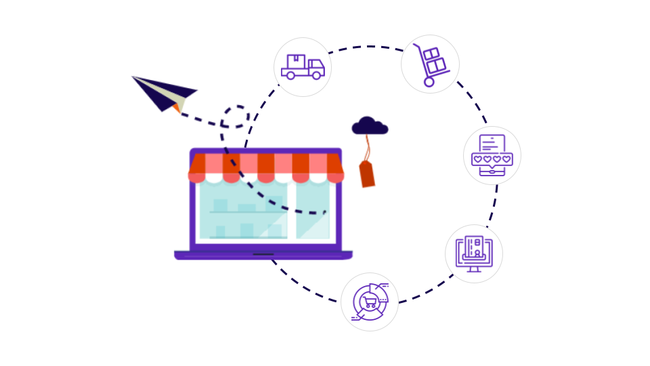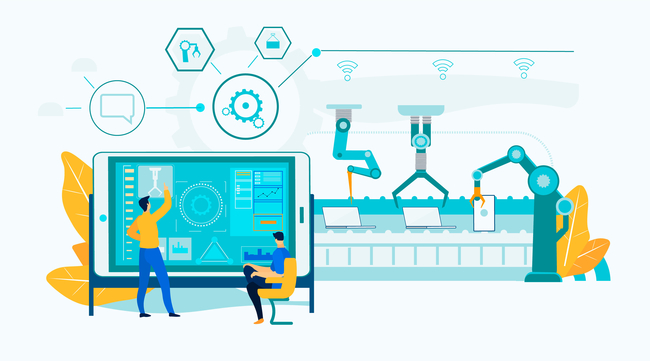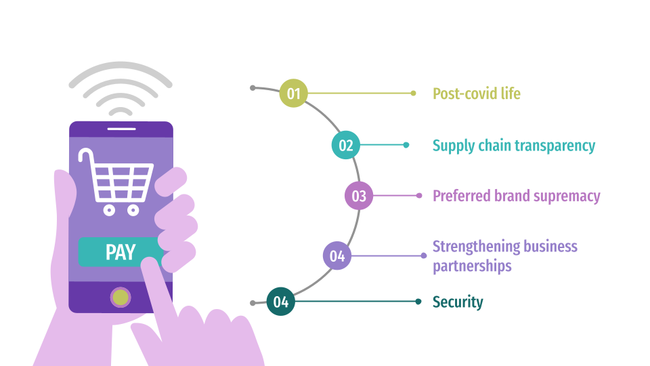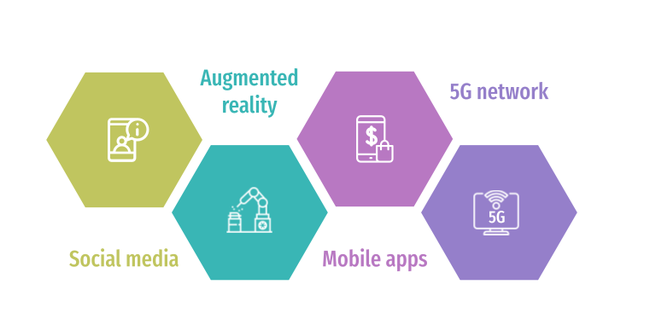The pandemic hasn't stopped me from buying or trying new goods in the name of safety.
Personalized purchase advice from brand experts every time I visit an e-store has become the favorite part of my purchase process lately.
It's nothing new now, to be able to test new items without even touching them.
All of these by simply relaxing on the sofas.
What connects the above statements?
(Hint : Our take on making ecommerce extraordinary covers a part of it!)
Yes, you guessed it correctly. What makes them possible is “Retail digital transformation”!
According to "Statista", more than two billion individuals shopped online in 2020, and the figure has been steadily rising since then. With the massive growth in the number of online shoppers, the competition has tightened as well. . To survive through such neck-to-neck competition, businesses are turning to new technology to build a stronger network with their target market.
Given that, changing your business from "conventional" to "digital" would undoubtedly speed up your process of creating an impact since customers now like to shop from the comfort of their own homes. But to what extent? That only depends on how effectively you plan and execute your retail digital transformation!
Get Complimentary Retail Digital Transformation Consultation
So, without further ado, let's get down to the nuts and bolts of remodelling your retail store :
What is retail digital transformation?
Have you ever considered upgrading your current business operations in a way that translates to overall revenue increase and taking it to the next level? OR, have you ever thought to yourself, "How to accelerate business processes so that I get improved outcomes (quality & quantity wise) within a lesser time span ?"
Either way, there’s one wholesome solution for you – retail digital transformation.
But at first glance, you may have several questions about the concept of digital transformation in the retail context.
Simply put, retail digital transformation is basically a business strategy that uses technologies to streamline business processes in order to maximize accuracy & precision while optimizing resource allocation and contributing to a greater value proposition to the customers. To incorporate digital transformation into your retail business you have to have a clear vision of the ‘current’ and ‘desired’ state of every aspect of your business like – sourcing, pricing, inventory planning, customer service methods and all other similar factors. With a clear goal in mind it will be easier for you to determine a precise digital remodelling route-map for your retail business.
Technical nitty-gritties of retail digital transformation
Technology forms the backbone of retail digital transformation. So to help you ensure your retail digital transformation stands upright in this competitive market, here's a clear tech close-up :
[1] Data analytics
Data analytics plays a versatile role in retail digital transformation as it helps in multiple areas of a retail business by making all the essential stats and insights available just a couple of clicks away. From ‘performance of specific offerings’ to ‘which of your strategies are bearing expected results & which are not’ and many alike – all gets easier than ever ~ courtesy data analytics!
Targeting some strategic areas with the help of data analytics :
[i] Forecasting future performances
Executing an idea without fully understanding it can be risky, because apparently one small decision can lead to a significant loss.
To avoid such probabilities of settling down with wrong decisions, data analytics for retail business forecasts the future performance of your offerings based on customer preferences and dislikes. With the help of predictive analytics, drawing nearly accurate predictions for the future becomes a lot easier.
[ii] Demand forecasting
After getting a rough idea of customers’ purchase trends, you can focus on specific areas of your offerings for optimizing stock. Like in the case of specific products or services where there is proven high demand from the near past or a timeframe against similar situations (festivities or seasonal – for instance). Predictive analytics with the help of traditional statistical forecasting and machine learning algorithms can easily help you detect such high-demand as well as low to no demand areas.
[iii] Risk detection
Incorporating a divide and conquer approach with data analytics is a great way to determine any likelihood of consumer default by evaluating their recent expenditure. With the help of this approach, you can reduce hazards and frauds.
[iv] Customer interaction
Simply put, as the name suggests – ‘customer interaction’ is communication between your brand and a customer. So the question now is, how is it done best? Basically, there are several ways to boost customer interaction. To name a few, you can do so by using social media platforms, incorporating chatbots to answer basic queries with a human touch, by using virtual reality .
[2] Artificial intelligence
Who would have thought that 20 years ago, everything from virtual assistants to self-driving cars would be an accessible reality?
Artificial intelligence has enhanced the business world inside out and the retail sector is not an exception.
But the question is, as a retailer, how would you use artificial intelligence to make your retail business the "new hot topic" in town?
So, let's have a look at the ways artificial intelligence can enhance your business processes :
[i] Enhancing customer service
AI can assist retailers in providing smooth customer support in various scenarios, from automated checkouts to customer mood tracking for a personalized response and a lot more. With an AI driven customer service module, no visitor goes off unattended and a custom consultation improves chances of closing more deals.
How, you wonder?
By quickly analysing customer interactions and performing text analytics on their thoughts and feelings. With that, it can also detect the intensity of certain words and access their emotions.
[ii] AI-enabled chatbots
With an AI-enabled chatbot you basically have an automated customer servicing in place that is up 24*7 so you attend to potential customers every hour of the day. After time, the next issue with customer servicing is handling thousands of customer queries with a ‘polite’ attitude. Let’s face it – just like your customers, your employees are human too and keeping them at gunpoint doesn’t change the fact that they too lose their cool sometimes! Thank God for the chatbots, as they take up the engagement factor by notches minimizing customer grievances by getting them relevant information almost instantly, that too, without any ‘Please hold up while I connect you to so & so” leading to “Sorry! We don’t have an answer for your question right now”. Talk about assisting customers with product or service description, customized shopping recommendations or getting them the offers they may hate missing – a chatbot can cover all these & more.
[iii] Visual search
How many times did you try finding a product by its ‘probable description’ as the product name you didn’t remember? This has happened to me several times as I tried searching for the ‘blue box new cookie brand’ and found 50 others but not the one I wanted! This is exactly the disappointment visual search saves you from – all you need to do is just upload a picture and you’ll have a list of similar products topped with the product you were looking for, if available.
[iv] Mood tracking
Mood tracking, as the name suggests, helps you know how to treat whom and thus, keep the customer satisfaction higher without having to maintain multiple customer servicing teams working in rotational shifts. Basically, with a mood tracking system, you don’t have to brush off an unhappy client with just another generic response, increasing grievances. Even when ‘change’ continues to be the only ‘constant’ in the retail world, the customer remains the king and the better you serve them the better growth you’ll attain!
[v] Virtual dressing rooms
Standing in line to get into a dressing room has never been the best thing about shopping, and the fear-of-contamination after the pandemic has only made it feel worse. On the other hand, shopping for things without a trial isn’t a great option either. Virtual dressing rooms solve that exact gap as it helps execute a try on without physically entering into a trial room i.e. online.
How?
Basically the AI technology positions the item on the customer's image to have a better understanding of the size, style, and color. This way, customers can get a good idea of what suits them and what does not without stepping out of their homes.
[3] Internet of things (IoTs) in retail technology
IoT development facilitates retail digital transformation as it helps make the bridge building process between the firm and customers easy by providing the customers with more personalised shopping experience. This in turn, helps retail businesses boost sales, consumer satisfaction, and loyalty.
So, let's take a look at how IoTs can help with retail digital transformation :
[i] Monitoring and predicting in-store wait times
In the midst of a pandemic, predicting in-store wait times is a significant advantage of IoT technology in retail. Long lines at cash machines increase the risks associated with COVID-19 and reduce customer retention rates. It's not just the wait that irritates customers; it's also the inability to predict how long they'll be waiting.
You can include IOTs into your retail business to manage in-store wait times. Additionally, it can also assist your workers in identifying customers who are waiting in line for an extended period of time and providing them with interesting activities to make the time in line more bearable.
[ii] Product delivery time and status
The pandemic has influenced customer behavior to a great extent. Customers are shopping online more often than before. This has not only raised the need for delivery services but has also put them under strain. Customers now want their goods to be delivered faster while maintaining all safety precautions.
IoTs can be incorporated by your retail brand to ensure your customers with quick delivery. This technology will also enable you to create delivery status updates, allowing users to see the location of their orders in real-time.
Learn all about choosing the best ecommerce order management system!
[iii] Self checkouts
Using IoT, a self-checkout system that allows consumers to pay for their products without human interaction can be simply set up. The system will read the tags on each item and automatically debit money from the customer's online payment app. This will not only make your customers happy but it will also make them visit your store again and again.
[iv] Smart shelves
You may have had difficulty managing your inventory and tracking each item ensuring that they were not out of stock. But, with smart shelves, you can say goodbye to those hassles. Sensors on smart shelves track each item in real-time. Smart shelves, in addition to tracking products, can also detect theft using RFID technology.
Why is retail digital transformation more relevant now?
Digital transformation enables retail businesses to adapt to changing customer needs and thrive in the future. From our discussion so far it’s pretty clear that retail firms can gain a competitive advantage through retail digital transformation in an economic environment that is constantly changing due to technological advancements.
Competitive advantage is a broad term – to understand it better, let’s answer a defined question, why exactly are retail businesses increasingly embracing digitalization at this point in time?
So, let's take a look at why retail businesses are doing so :
[i] Post-covid life
Given the pandemic scenario, most individuals are staying home and spending solely on necessities. As a result, retail firms with a digital presence are becoming extremely popular. Such shops are capitalizing on the pandemic scenario by increasing market share through innovation and client acquisition.
So, rather than shutting or declaring bankruptcy, you should continue with your retail digital transformation program.
Read more: Technology Trends In The Pandemic Era : Silver Lining to COVID – 19
[ii] Supply chain transparency
The pandemic has disrupted global supply networks, causing many retail businesses to be unable to satisfy customer demand for their products. But, with retail digital transformation, you don't need to worry about that. Retail digital transformation improves supply chain transparency by providing immediate notifications such as when to restock items, which products are out of stock, and easy inventory management.
[iii] Preferred brand supremacy
Our lives have been drastically altered since the pandemic. Customers are impacted by social distancing, personal hygiene, queuing for store access, and other limitations.
So, rather than hopping from one store to the next, people are rooting for their favorite brands and expecting them to service all their needs at one place and that too without compromising quality and safety.
[iv] Strengthening business partnerships
Demands from customers are increasing, so is the competition. Retail companies are becoming increasingly dependent on one another, collaborating with suppliers and distributors, subcontractors, and specialized consultants to provide a broad variety of products and services that appeal to customers. Managing these partners frequently requires document-based communication, which can be regarded as a time-consuming barrier to productivity. But, with retail digital transformation, the process can be changed. Using an eSignature system can result in a more transparent, fast, and accurate workflow.
[v] Security
One of the most vital aspects of running a retail business is security. But, with retail digital transformation, the task becomes much simpler. Thefts are becoming highly concerning in the middle of the pandemic, but they can be readily preventable with biometric cybersecurity scanners. With biometric cybersecurity scanners, your body becomes the "key" to unlock your access; only scans that are recorded in the database are authorized, the rest are refused.
What are the top digital trends in the retail industry?
Covid-19 has taken a clear toll on global purchasing patterns and thus, e-shopping has become a preferred priority for obvious reasons (yeah, lockdowns!). With such a shift in customer purchasing habits, the 2020’s have witnessed a larger number of all businesses, especially from the retail sector, onboarding a digital transformation in order to successfully capture and retain the target audience base amidst the neck-to-neck competition.
Let’s have a look at what’s hot in the retail digital transformation space these days:
[i] Augmented reality
Color to texture, packaging to product labels – who thought checking all these and more right from the couch comfort can get more ‘real’, well beyond 360 degree images? Thanks to augmented reality for making this possible! Whether it’s a glare’s try-on or a footwear trial – incorporate an AR module to provide your users an absolute at-store product browsing experience while they are at home, maybe struggling with stretched work-from-home hours!
[ii] Mobile apps
The fact that mobile apps have become the apple of our eyes for almost every other need, be it daily or occasional, doesn’t need much stats to make sense of. Considering such mammoth attention around mobile apps, one of the quickest ways to customer engagement becomes evident. Slip in their smartphones or laptops – show them the ‘new arrivals’ to ‘hot sellers’ flash your real reviews – update them on offers & discounts running and make browsing and shopping a breeze to your customers. Don’t forget to enable customer support so their issues are resolved much before it turns into a grumpy grievance.
The best thing about mobile app development?
It caters to the retailers’ and customers’ interest alike! Satisfies the customers with convenience galore while making it easy for you to add more features in the long run to keep your service up to date.
[iii] Social media
Social media is a goldmine of insights and with the numbers showing that globally 4.2 bn people actively use social media only stands by that statement. From visibility to traffic, spreading brand awareness to consistent interaction, – being a one-stop multi-purpose platform social media has lately become a ‘trend’ which is here to stay. No wonder platforms such as Facebook, Instagram, and Twitter were quick to have the commercial goals onboard, and their "purchase" buttons speak for that.
Ever thought of building YOUR own social media app? Bingo – our guide is what you won’t want to miss then!
[iv] 5G network
Going digital is the "new normal" in today's world, and with retail firms struggling to manage operations from home and remote locations, the need for digitalization has risen significantly.
5G had already been in the news last year, but now it’s on the verge of gaining prominence. With 5G network, providing parallel speed and connection is as easy as “1+1= 2”. The adoption of 5G will not only improve IoT connectivity, but will also improve user experience, digital collaboration, and will speed up retail digital transformation.
Conclusion
So, whether you're a brand-new startup aiming to make a mark in the retail industry or an established company looking to take the next big leap with an upscale process, retail digital transformation can help you achieve both.
All that you need is the right plan to follow and the right team to execute your plan with the precision it deserves!
And, if you’re looking for some promising ecommerce business ideas then go ahead and check out 11 Ecommerce Business Ideas










